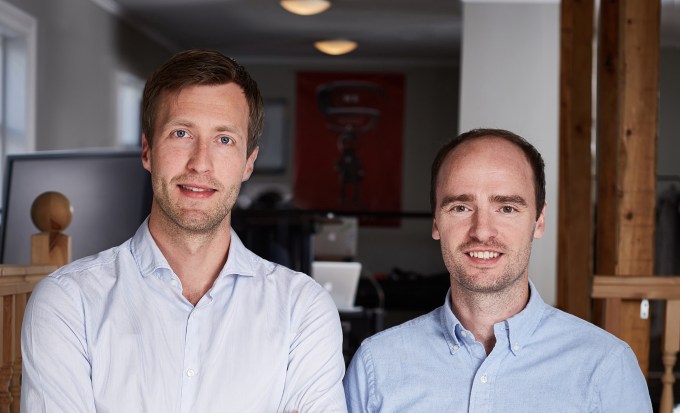Nordic digital therapeutics company, Sidekick Health, has closed a $20 million Series A led by pan-European VC Wellington Partners and healthcare focused VC Asabys Partners. Existing investors, Novator and Frumtak Ventures, also participated in the oversubscribed round.
The 2014-founded startup has built a gamified digital care platform that targets chronic and lifestyle disease management via digital nudges from a helmet-wearing cartoon helper — pushing patients toward relevant information to support more beneficial lifestyle choices (e.g. taking regular exercise, or cutting down on smoking), as well as offering help with patient treatment management, such as via digital reminders for taking medication and remote patient monitoring for clinicians.
Sidekick Health’s platform addresses multiple therapeutic areas — offering what’s described as ‘evidence-based’, custom gamified digital therapeutics packages for conditions including diabetes, ulcerative colitis and smoking cessation.
This year it’s also branched out to offer support for patients with COVID-19 — an acute (rather than chronic) condition, albeit one that’s created huge and pressing challenges for healthcare providers.
The pandemic is of course more generally driving demand for digital care and remote patient monitoring as healthcare providers look for tools to help manage patients off-site — providing another tailwind for Sidekick Health’s business.
And while its gamification approach might seem more immediately suited to younger, app-savvy users, since launching the platform it says it’s worked with patients who are teenagers all the way up to people well over 80 — and now believes there are few limits on who can tap in to its digital care, assuming it can nail designing for easy access. Its software is designed to be accessible via (and integrate with) a range of connected devices.
“Our market, digital heath in general and our part of it, which you can either call digital care or digital therapeutics, has been fast growing over the past few years,” says CEO and co-founder Dr Tryggvi Thorgeirsson. “Obviously with the pandemic the whole trend has just been accelerated. That means accelerated adoption by more or less all the stakeholders in the market. And maybe especially by payers and providers.
“If you look at providers — like hospitals, clinicians — they have of course by necessity had to increase their use of digital health tools due to the pandemic. So the market was very fast growing already but with the pandemic it has really accelerated. So our customer base has been growing quite sharply now in the past six to 12 months.”
Sidekick Health doesn’t break out customer numbers but says it’s working with “several” of the top global pharma companies at this stage. While the platform reaches around 30,000 patients across different therapeutic areas via its b2b customers — with Europe it’s biggest market so far.
The new funding is going towards “further growth”, per Thorgeirsson — “both in terms of expanding the product but also accelerating our growth in both Europe and into the US market”. “We’re investing funds into the growth instead of aiming for profitability at this point,” he adds.
New conditions he says it’s set to expand into “over the next few months” include heart failure; oncology (supporting patients with different types of cancer); and a number of metabolic conditions.
Within two years he says he wants it to be able to address over 20 different types of chronic illness (plus “a few acute ones like COVID-19”).
Thorgeirsson also notes that people who are dealing with chronic conditions often suffer from multiple conditions — so being flexible enough to manage patients with comorbidity has been a strong focus for the clinician-founded startup.
“Most of our work is in chronic, lifestyle-related conditions… but when COVID-19 hit we saw that all of this functionality we had built for chronic diseases in our view was quite fitting for COVID-19 as well,” he says, explaining that the platform has been used to support coronavirus patients with educational videos on symptoms and “how to cope with the anxieties of being in home isolation”, as well as offering a reporting conduit to clinical staff to remotely monitor COVID-19 patients.”
“We felt all of these [features] were relevant also for this acute condition, so here in our home country, Iceland, we offered help and were picked up by the national authorities to support with a nationwide program to remotely monitor and support patients with COVID-19. So it definitely can apply in certain acute conditions as well,” he adds.
In addition to expanding the range of conditions the platform can address, the Series A funding will go on more clinical research aimed at validating its approach.
Recent research it’s published includes a random control trial comparing full standard care for type 2 diabetes vs the same full standard care plus its platform on top. (On that study, Thorgeirsson says the addition of the digital tool in the care pathway led to “a very significant drop in average blood glucose” which “translates to about 16% less risk of death and about 30% less risk of serious complications like amputation and blindness”.)
“One of the things we’re going to be using this funding for is to vastly increase our medical and science operations — so launching multiple studies into multiple therapeutic areas,” he tells TechCrunch. “Every condition has different aspects that we do focus on. With cardio and metabolic conditions it’s things like improving weight control, blood glucose, cardiovascular risk factors. Whereas in others it might be more focusing on quality of life or fatigue or anxiety or depression.
“This summer we did feasibility testing with patients with heart failure. And we saw really exciting first indications that we significantly improved one of the main symptoms [shortness of breath]. We saw very significant improvement in those symptoms… We even had a case where the remote patient monitoring of the heart allowed the clinicians to pick up a silent ‘heart attack’ — and led to an immediate hospitalization of a patient.
“So in general what I’m excited about is to see the breadth of the applicability. We started out in the cardiovascular space but over the past two years have been really fast expanding into a bunch of new conditions.”

Sidekick Health co-founders, Dr Sam Oddsson and Dr Tryggvi Thorgeirsson (Photo credit: Sidekick Health)
The startup operates a b2b2c model in partnership with pharmaceuticals companies and healthcare providers who then offer the software to patients — recently inking deals with US pharma giant pfizer and German giant Bayer, with more touted in the pipeline.
A line on its website refers to the added “value” its platform can deliver for its business customers. Asked what that means in practice Thorgeirsson argues that digital therapeutics offers “multiple value levers” to pharma partners.
One key point to note here is that digital care/therapeutics tools continue to face regulatory barriers to being directly reimbursed by healthcare payers in many markets. So such businesses typically need to find alternative routes to market.
Working with big pharma is one option. Although some digital health startups are, conversely, aiming to more directly disrupt the pharmaceutical industry — i.e. by offering an alternative to taking drugs (such as in areas like sleep disorders). However Sidekick Health sees its platform as a treatment complement that can augment traditional drug therapies for a wide range of conditions. (While, on the flip side, it says it believes its chosen b2bc route is the best way to get its digital therapeutics in front of as many patients as possible.)
“Improving patient outcomes has a direct financial benefit for our pharma customers,” says Thorgeirsson, discussing the value proposition Sidekick Health offers its b2b partners. “If you have a drug that might have cost anywhere between $1-$3 billion [to bring to market] and if we can then help improve the efficacy of treatment for patients that are receiving that therapy by adding our digital companion to that drug that has a direct financial benefit in terms of competitive standing for our pharma partners.
“Also when our pharma partners discuss reimbursement for their drug with payers improved patient outcomes of course are key — so it’s the improved patient outcomes, it’s the improved medication adherence (we know that’s a huge problem; about 300,000 people die every year due to lack of medication adherence which is something that we help with); and then of course very interesting insights from real world data that we are able to gather as well.”
The potential for data generated by digital therapeutics to be used to extend the life of existing drug patents also “comes into the discussion” here, per Thorgeirsson — when we ask whether part of its ‘value add’ is the potential to extend the profitable shelf-life of existing drugs by injecting new life into pharmaceutical patents via bolting on a novel digital companion.
“That is one of the things that is extremely exciting in our space — working much more closely with pharmaceutical companies creating combinations of molecule plus digital,” he confirms. “In some cases, yes, this can potentially expand exclusivity or patents. So that’s absolutely a really interesting part of what we see happening in the market.
“This combination where the molecule can impact certain areas of the disease and we impact others — and the combination is more powerful than either alone.”
Drug development and/or finding new applications for existing medications is another area where Sidekick Health reckons that data derived from its platform will be able to aid pharma outcomes.
“The way we see it is that any new drug that’s being developed, in the not too distant future, most likely will have a digital companion when they go to market,” says CMO Gulli Arnason. “[It’s about] getting in early and launching something with a pharmaceutical company that’s augmented by a digital companion — as well as a more defensive play, around margins and patents. So these two areas are extremely important for pharmaceutical companies.”
As for the healthcare payer market, that’s “still maturing” in its response to digital therapeutics, as Thorgeirsson puts it. (Again, though, the coronavirus pandemic is kicking open doors as societies hurry to adopt digital tools to scale to meet the spike in demand for remote care.)
“What we feel is important also is that current value levers which are not dependent on direct reimbursements from payers because we know that the payer market is still maturing — really interesting things happening there but still kind of developing,” he adds.
On the competitive landscape, Thorgeirsson argues that Sidekick’s platform-play is relatively rare — and sets the business apart from digital therapeutics startups with a more niche focus. (One platform competitor he does name-check is France’s Voluntis; a business that’s been working on ’embedding connectivity into therapeutics’ for considerably longer, though with less of a focus on gamification.)
“There are companies that focus more narrowly on certain elements — like only on medication adherence or only on one or two specific conditions but we have this different approach where we believe it’s absolutely key to have a platform approach. And that’s really both when you look at the patient side — patients might have two or more conditions, they might have obesity, type 2 diabetes and smoke, and you don’t want one solution per condition; you want a platform that can tackle all of them,” he suggests, adding: “In general we don’t see strong competition when you combine the gamification, the outcomes that we’re showing and the platform approach.”
The platform approach aligns Sidekick Health with the needs of its target business partners.
“Our business partners have the same [priorities],” argues Thorgeirsson. “They have a portfolio of therapeutic areas that they address and they really don’t want one vendor per therapeutic area but a platform that can tackle across the spectrum. And when it come to the platform breadth we don’t really see a large number of competitors with that size of a platform.”
Commenting on the Series A in a statement, Dr Regina Hodits, managing partner at VC firm Wellington, said: “At Wellington, we are all about improving healthcare for all stakeholders, patients, practitioners, and payors alike. Sidekick’s team has done a remarkable job of creating a product platform with the potential to achieve this aim on a global scale. We are very excited to support the company with their plans for significant growth.”
“We are impressed by the way this team has been able to put together a technology platform delivering evidence-based therapeutic programs, that are effective, adaptive but also valuable for their commercial partners,” added Josep LI. Sanfeliu, managing partner and co-founder of Asabys, in another supporting statement.



